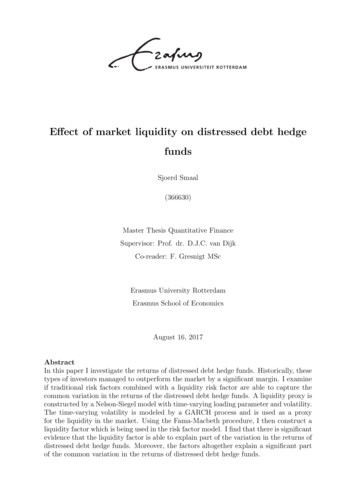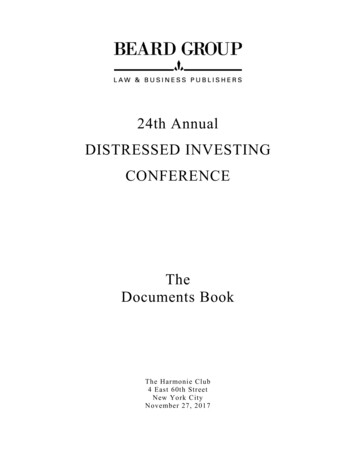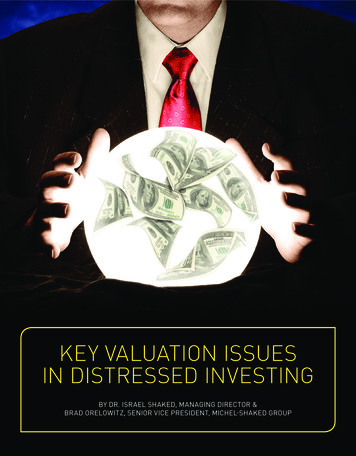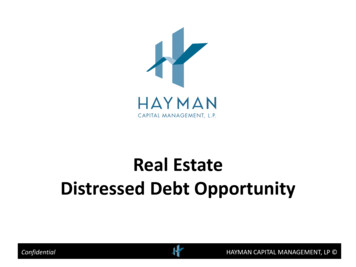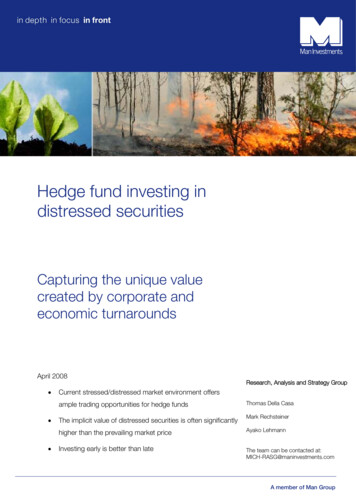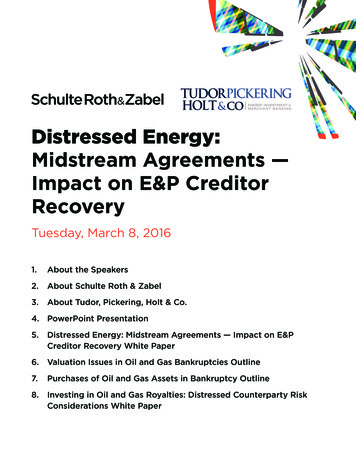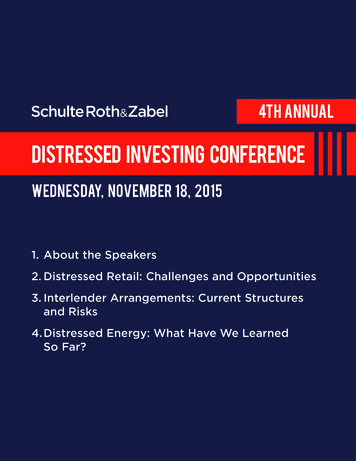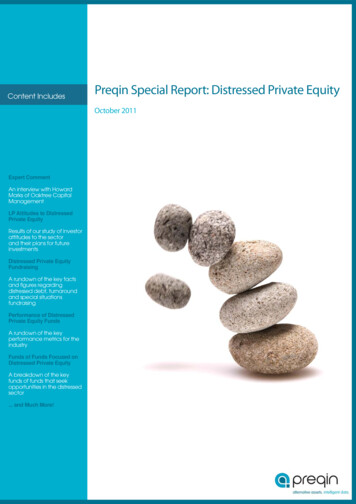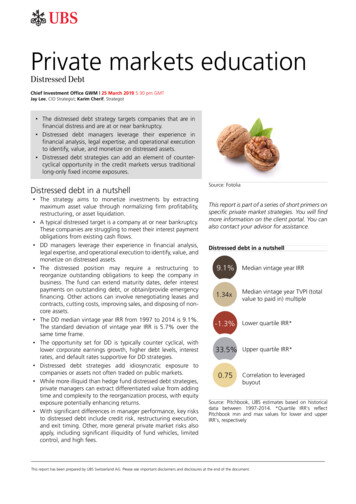
Transcription
Private markets educationDistressed DebtChief Investment Office GWM 25 March 2019 5:30 pm GMTJay Lee, CIO Strategist; Karim Cherif, Strategist The distressed debt strategy targets companies that are infinancial distress and are at or near bankruptcy. Distressed debt managers leverage their experience infinancial analysis, legal expertise, and operational executionto identify, value, and monetize on distressed assets. Distressed debt strategies can add an element of countercyclical opportunity in the credit markets versus traditionallong-only fixed income exposures.Distressed debt in a nutshell The strategy aims to monetize investments by extractingmaximum asset value through normalizing firm profitability,restructuring, or asset liquidation. A typical distressed target is a company at or near bankruptcy.These companies are struggling to meet their interest paymentobligations from existing cash flows. DD managers leverage their experience in financial analysis,legal expertise, and operational execution to identify, value, andmonetize on distressed assets. The distressed position may require a restructuring toreorganize outstanding obligations to keep the company inbusiness. The fund can extend maturity dates, defer interestpayments on outstanding debt, or obtain/provide emergencyfinancing. Other actions can involve renegotiating leases andcontracts, cutting costs, improving sales, and disposing of noncore assets. The DD median vintage year IRR from 1997 to 2014 is 9.1%.The standard deviation of vintage year IRR is 5.7% over thesame time frame. The opportunity set for DD is typically counter cyclical, withlower corporate earnings growth, higher debt levels, interestrates, and default rates supportive for DD strategies. Distressed debt strategies add idiosyncratic exposure tocompanies or assets not often traded on public markets. While more illiquid than hedge fund distressed debt strategies,private managers can extract differentiated value from addingtime and complexity to the reorganization process, with equityexposure potentially enhancing returns. With significant differences in manager performance, key risksto distressed debt include credit risk, restructuring execution,and exit timing. Other, more general private market risks alsoapply, including significant illiquidity of fund vehicles, limitedcontrol, and high fees.Source: FotoliaThis report is part of a series of short primers onspecific private market strategies. You will findmore information on the client portal. You canalso contact your advisor for assistance.Distressed debt in a nutshell9.1%Median vintage year IRR1.34xMedian vintage year TVPI (totalvalue to paid in) multiple-1.3% Lower quartile IRR*33.5% Upper quartile IRR*0.75Correlation to leveragedbuyoutSource: Pitchbook, UBS estimates based on historicaldata between 1997-2014. *Quartile IRR's reflectPitchbook min and max values for lower and upperIRR's, respectivelyThis report has been prepared by UBS Switzerland AG. Please see important disclaimers and disclosures at the end of the document.
Private markets educationWhat does the distressed debt strategy do?The distressed debt (DD) and special situation strategies compriseUSD 339bn, or 6% of private markets AUM. DD is a subset of abroader special situation strategy umbrella, which aims to providefinancing in areas of stress or dislocations appearing at any stageof the economic cycle.The distressed debt strategy targets companies that are in financialdistress and are at or near bankruptcy. The strategy aims to monetize investments by extracting maximum asset value through normalizing firm profitability, restructuring, or asset liquidation. Distressed securities are often undervalued by the market given: 1)difficulties conducting financial analysis on troubled companies, 2)presence of complex legal situations, and 3) lack of reliable externalsources of information on the company.Target investments A typical distressed target is a company at or near bankruptcy.These companies are struggling to meet their interest paymentobligations from existing cash flows. The company can enter distress as a result from over leveragedbalance sheets, loss of competitive position, litigation/regulatory challenges, or lack of access to capital. The distressed borrower can be publicly traded or private.Opportunities to purchase distressed debt can present themselves when debt owners (mutual fund or institutional investor)are mandated to sell out of the distressed credit given holdingrestrictions. Additionally, DD funds can identify private borrowers with businesses that are not tracking to plan.Restructuring processDistressed debt managers perform financial analysis to estimate thecash flows and liabilities of the underlying company, along withlegal due diligence to understand contractual rights and obligationsto help navigate bankruptcy laws. Active distressed debt strategies can accumulate large positionsin the company's debt or equity at steeply discounted prices togain a controlling position to influence decisions. The distressed position may require a restructuring to reorganize outstanding obligations to keep the company inbusiness. During a restructuring, the DD fund can extend maturity dates,defer interest payments on outstanding debt, or obtain/provideemergency financing. Other actions can involve renegotiatingleases and contracts, cutting costs, improving sales, and disposing of non-core assets. The fund can also form creditor committees and serve on the board of directors to influence outcomes. The DD fund can exchange part of their debt with post reorganized equity positions that can enhance returns upon companyrecovery. The restructuring process can be accomplished through aprivate workout between lenders and borrowers to renegotiateterms on the loan that is in default. Out of court workouts canbe less costly and provide flexibility in negotiating terms versusgoing through bankruptcy courts. Though more costly, bankruptcy courts can provide formal legalprotection against creditors and allow for the company to continue as a going concern.Fig. 1: The private market industry has grownrapidly in the last decadeWith USD 339bn, distressed debt and special situation comprises 6% of private markets AUMIn , Trillions 6.0 5.7T6% 5.0 4.0 3.0 2.1T 2.05% 1.0 0.020072018Distressed/Special SitsDirect lendingMezzanineInfrastructure/Nat. ResourcesReal EstatePrivate equitySource: Preqin. Total exposure (unrealized value drypowder) as of year-end for 2007, 30 June for 2018Fig. 2: Illustration of financial distressDistressed investing can involve various scenarios,with or without court involvementNo outReorganizeand EmergeFinancialrestructuringBankruptcyMerge withanother firmLiquidationSource: Karen H. Wruck, "Financial Distress: Reorganization and Organizational Efficiency" Journal ofFinancial Economics (1990).2
Private markets education Otherwise, the company can be liquidated if the company'svalue as a going concern is deemed worth less than thecompany's assets. In this case, a DD fund that purchases debt(usually senior in the capital structure) at a steep discount mayprofit if the recovery value is higher than the purchase price.Holding period and exit A typical investment period is around 3-5 years, with the life ofthe fund averaging 10 years. Returns are primarily derived from capital appreciation as debtpurchased at discounts are 'pulled to par' from refinancing orsettlement of held securities (for example, purchase debt at50 cents on the dollar, recover 70 cents), plus any income distributed from debt securities. Returns can vary depending onleverage use, which tends to be limited. Multiple exit options for post reorganized assets include a saleto a strategic buyer, IPO, recapitalization with existing owners,or sale of securities back into the market.Sources of value-addDD managers leverage their experience in financial analysis, legalexpertise, and operational execution to identify, value, and monetize on distressed assets. Extensive sourcing capabilities: Managers that have deepindustry knowledge and a network of financial/legal advisorscan source a wider net of potential opportunities and provide afirst mover advantage for transactions and thereby avoid competitive auctions. Rigorous credit analysis: Rigorous fundamental creditanalysis helps evaluate the merits and nuances of each situation, especially for more complex and illiquid assets that aredifficult to value. Experience across multiple credit cycles canprovide better insight into potential opportunities. Flexibility across region, sector, capital structure: Flexibility to invest across different countries, industries, and acrossvarious parts of the capital structure (debt and equity) canwiden opportunities in different macro environments. Legal expertise: Fund teams will require extensive resourcesto carry out legal due diligence. Knowledge of regional bankruptcy laws and credit agreements are crucial to navigating thedistressed investment process. Restructuring experience: Exerting influence among othercreditors, formulating/executing restructuring plans, anddeploying operating executives to stabilize cash flows can helpimprove portfolio company prospects. Managing the exit process: Fund managers engage withinvestment bankers and solicit buyers to negotiate exit optionson behalf of investors to best monetize invested assets. Managers must also time exits appropriately given the potentialcyclicality of underlying holdings.3
Private markets educationPerformance analysisIntroduction to vintage year returns Private market returns are assessed using vintage year performance, which reflects the sum of all cash flows (contributions,distributions) from funds incepted in the referenced year. For example, if hypothetical fund ABC reported vintage year2005 IRR of 15%, ABC was incepted in 2005 and the IRRreflects all investment activity performed over the course of itslifecycle: contributions and distributions made in 2005, 2006,2007, etc., until the end of the fund. If hypothetical fund XYZ reported vintage year 2008 TVPI of1.3x, the fund returned USD 1.30 for every USD 1 investedthrough the duration of the fund's life.Fig. 3: Distressed debt IRR per vintage year1997-2014High level of dispersion within each vintage yearshows importance of manager selectionIn %4035302520151050(5)1997 1999 2001 2003 2005 2007 2009 2011 2013Distressed IRR medianHistorical performance The DD median vintage year IRR from 1997 to 2014 is 9.1%.The standard deviation of vintage year IRR is 5.7% over thesame time frame. The DD median vintage year TVPI from 1997-2014 is 1.34x. Thestandard deviation of vintage year TVPI is 0.15x over the sametime frame. When comparing performance versus leveraged buyout funds,we observe correlation of 0.75 for vintage years 1997-2014.The return pattern is similar as vintage years involving highlevels of market dislocations (2001, 2009) provided attractiveentry opportunities for both strategies. We observe a wide range of IRRs for each vintage year, highlighting the importance of manager selection when consideringdistressed debt strategies.Distressed debt and the business cycle The opportunity set for DD is typically counter cyclical, withlower corporate earnings growth, higher debt levels, interestrates, and default rates supportive for DD strategies. However, we note that managers that employ broader 'specialsituations' strategies can provide liquidity in markets experiencing dislocations caused by non-macro/idiosyncratic factors,which can present potential opportunities across the economiccycle. Distressed debt returns experienced vintage year median IRRpeaks during market stress (2001, 2009). These years producedoutsized returns given valuation dislocations, limited access tocapital, and increased default rates. Distressed debt experienced lower median IRR between 1997and 2005, corresponding to vintage years occurring 3-4 yearsbefore equity peaks. During these years, return prospects moderated given benign macro environments. Recent vintage years (2011-2014) have also exhibited moremoderate returns given the limited number of defaults and dislocations experienced in the credit markets.IRR 25thIRR 75thSource: PitchbookFig. 4: Distressed debt and leveraged buyoutvintage year IRR comparison 1997-2014Return profile between distressed debt andleveraged buyout have been similarIn %3025201510501997 1999 2001 2003 2005 2007 2009 2011 2013Distressed IRR medianBuyout IRR medianSource: Pitchbook, Cambridge AssociatesFig. 5: High yield spreads and leveraged loandefault ratesWidening spreads and higher default rates canindicate a supportive market for distressed managersSource: Federal Reserve of St. Louis, S&P LCD, UBS Estimates. Note: Leverage loan defaults reflect (Last 12month of defaults) / (total outstanding)4
Private markets educationDistressed debt in your portfolio Distressed debt strategies can offer an element of contrarianand countercyclical opportunities in the credit markets versustraditional long only fixed income exposures. Distressed debt strategies add idiosyncratic exposure to companies or assets not often traded on public markets. While more illiquid than hedge fund distressed debt strategies,private managers can extract differentiated value from addingtime and complexity to the reorganization process, with equityexposure potentially enhancing returns.Risks Distressed strategies incur a high level of credit risk withpotential widening of spreads and price fluctuations given thetroubled nature of underlying companies/assets. Managers may face trading restrictions (for legal or marketreasons) and may not be able to sell an asset at the desiredprice. Restructuring is a complex process. Many events are beyond themanagers' control, including unforeseen regulations, unsuccessful reorganization or miscalculation of underlying assets. While managers strive to seek investments across the marketcycle, a lack of opportunities can erode investor returns due tofees. Adverse market factors could negatively impact the exitenvironment for certain investments. Given the time and resources required to analyze and workthrough restructurings, managers may hold fairly concentratedportfolios Reputational risk can arise in investing with distressed debtstrategies. Some managers may engage in strategies perceivedto be controversial (e.g. vulture investing), which may result inlegal action or attract public and media criticism. Other, more general private market risks may still apply,including the lack of transparency, illiquidity, high fees, and longterm lock up periods. These risks cannot be fully eliminated, but can be reduced significantly through thorough due diligence and strict investmentand monitoring processes.5
Private markets educationAppendixSelected definitions Correlation: the degree to which the fluctuations of one variable are similar tothose of another.Leverage: the use of borrowed capital or instruments to increase the potentialreturn (but also potential losses) of an investment, a simple example is a mortgageused in real estate transactions.Leveraged buyout funds: a private equity strategy using borrowed capital to gaincontrol of a company.Illiquidity premia: the premium that an investor can demand depending on howdifficult it is to convert the underlying security can be converted to cash.Multiples: a term that measures some aspect of a company's financial well-being,determined by dividing one metric by another metric. The metric in the numerator istypically larger than the one in the denominator, because the top metric is usuallysupposed to be many times larger than the bottom metric.Multiple expansion: describes the way a particular valuation metric increases toreflect a higher value assigned to an underlying investment.Value add: describes the operational, business, or structural improvements privatemarket managers seek through underlying portfolio investments.Cash flows: cash flow is the net amount of cash and cash-equivalents beingtransferred into and out of a fund.Public Market Equivalent (PME): a method that converts public market returns toa benchmark that can be compared to private market returns.IRR: a return method used to evaluate private market investments and reflects thediscount rate at which the present value of an investment's future cash flow equalsthe cost of the investment.TVPI (Total Value to Paid In): a return metric that describes the total capitaldistributed back to the investor residual value left in the fund divided by investedcapital.Exit: the time period in which an investor can convert holdings into cash to beliquidated over a designated period of time.IPO: the first sale of stock by a private company to the public. Also referred to as an"initial public offering."Standard deviation: a measure of the degree to which individual values vary fromthe distribution mean. The higher the number, the greater the risk.Dry powder: refers to cash reserves kept on hand by a private markets firm tocover future obligations, purchase assets or make acquisitions.J-curve: illustrates a period of initial negative cash flows (contributions) towardspositive cash flows (distributions back to the investor) over a period of time.Sponsor: the general partner in a limited partnership who organizes and signs upinvestors.Secondary buyout: describes a sale between private market firmsTrade sale/strategic sale: describes a sale of a business to another businessoperating in a similar industry.Senior debt: loans or debt securities that have claim prior to junior obligations andequity on a corporation's assets in the event of liquidation.6
Private markets education Junior debt: loan or security that ranks below other loans or securities with regardto claims on assets or earnings. In the case of borrower default, creditors who ownsubordinated debt won't be paid out until after senior debt holders are paid in full.Vintage year: is the year in which the first influx of investment capital is deliveredto a project or company. This marks when capital is contributed by venture capital,a private equity fund or a partnership drawing down from its investors.M&A: mergers and acquisitions is a general term that refers to the consolidation ofcompanies or assets through various types of financial transactions. M&A caninclude a number of different transactions, such as mergers, acquisitions,consolidations, tender offers, purchase of assets and management acquisitions.Blind pool: money collected from several people which is put into a fund andinvested for their profit. It is left unspecified which properties are to be acquired.Unit economics: a measure of direct revenues and costs on a unit basis for aparticular business model.Minority stake: reflects a non-controlling interest that is less than 50% of aparticular entity.Spin off: describes the separation of an independent company from a larger parent.Control provisions: designed to provide a level of influence over significantoperational and business matters.Redemption rights: gives investors the right to force a company to repurchasetheir shares after a period of time.Idiosyncratic risk: risk associated with a narrow set of factors pertaining to aparticular company. Risk that has little association with overall market risk.Tag-along provisions: provides a minority shareholder the right to join in on a saleof a company that is initiated by a majority shareholder.7
Private markets educationNon-Traditional AssetsNon-traditional asset classes are alternative investments that include hedge funds, private equity, real estate, and managedfutures (collectively, alternative investments). Interests of alternative investment funds are sold only to qualified investors, andonly by means of offering documents that include information about the risks, performance and expenses of alternative investmentfunds, and which clients are urged to read carefully before subscribing and retain. An investment in an alternative investment fundis speculative and involves significant risks. Specifically, these investments (1) are not mutual funds and are not subject to the sameregulatory requirements as mutual funds; (2) may have performance that is volatile, and investors may lose all or a substantial amountof their investment; (3) may engage in leverage and other speculative investment practices that may increase the risk of investmentloss; (4) are long-term, illiquid investments, there is generally no secondary market for the interests of a fund, and none is expectedto develop; (5) interests of alternative investment funds typically will be illiquid and subject to restrictions on transfer; (6) may not berequired to provide periodic pricing or valuation information to investors; (7) generally involve complex tax strategies and there maybe delays in distributing tax information to investors; (8) are subject to high fees, including management fees and other fees andexpenses, all of which will reduce profits.Interests in alternative investment funds are not deposits or obligations of, or guaranteed or endorsed by, any bank or other insureddepository institution, and are not federally insured by the Federal Deposit Insurance Corporation, the Federal Reserve Board, or anyother governmental agency. Prospective investors should understand these risks and have the financial ability and willingness to acceptthem for an extended period of time before making an investment in an alternative investment fund and should consider an alternativeinvestment fund as a supplement to an overall investment program.In addition to the risks that apply to alternative investments generally, the following are additional risks related to an investment inthese strategies: Hedge Fund Risk: There are risks specifically associated with investing in hedge funds, which may include risks associated withinvesting in short sales, options, small-cap stocks, “junk bonds,” derivatives, distressed securities, non-U.S. securities and illiquidinvestments.Managed Futures: There are risks specifically associated with investing in managed futures programs. For example, not all managersfocus on all strategies at all times, and managed futures strategies may have material directional elements.Real Estate: There are risks specifically associated with investing in real estate products and real estate investment trusts. Theyinvolve risks associated with debt, adverse changes in general economic or local market conditions, changes in governmental, tax,real estate and zoning laws or regulations, risks associated with capital calls and, for some real estate products, the risks associatedwith the ability to qualify for favorable treatment under the federal tax laws.Private Equity: There are risks specifically associated with investing in private equity. Capital calls can be made on short notice,and the failure to meet capital calls can result in significant adverse consequences including, but not limited to, a total loss ofinvestment.Foreign Exchange/Currency Risk: Investors in securities of issuers located outside of the United States should be aware that evenfor securities denominated in U.S. dollars, changes in the exchange rate between the U.S. dollar and the issuer’s “home” currencycan have unexpected effects on the market value and liquidity of those securities. Those securities may also be affected by otherrisks (such as political, economic or regulatory changes) that may not be readily known to a U.S. investor.8
Private markets educationAppendixUBS Chief Investment Office's ("CIO") investment views are prepared and published by the Global Wealth Management business of UBSSwitzerland AG (regulated by FINMA in Switzerland) or its affiliates ("UBS").The investment views have been prepared in accordance with legal requirements designed to promote the independence of investmentresearch.Generic investment research – Risk information:This publication is for your information only and is not intended as an offer, or a solicitation of an offer, to buy or sell any investment orother specific product. The analysis contained herein does not constitute a personal recommendation or take into account the particularinvestment objectives, investment strategies, financial situation and needs of any specific recipient. It is based on numerous assumptions.Different assumptions could result in materially different results. Certain services and products are subject to legal restrictions and cannotbe offered worldwide on an unrestricted basis and/or may not be eligible for sale to all investors. All information and opinions expressedin this document were obtained from sources believed to be reliable and in good faith, but no representation or warranty, express orimplied, is made as to its accuracy or completeness (other than disclosures relating to UBS). All information and opinions as well as anyforecasts, estimates and market prices indicated are current as of the date of this report, and are subject to change without notice. Opinionsexpressed herein may differ or be contrary to those expressed by other business areas or divisions of UBS as a result of using differentassumptions and/or criteria. In no circumstances may this document or any of the information (including any forecast, value, index orother calculated amount ("Values")) be used for any of the following purposes (i) valuation or accounting purposes; (ii) to determine theamounts due or payable, the price or the value of any financial instrument or financial contract; or (iii) to measure the performance ofany financial instrument including, without limitation, for the purpose of tracking the return or performance of any Value or of definingthe asset allocation of portfolio or of computing performance fees. By receiving this document and the information you will be deemedto represent and warrant to UBS that you will not use this document or otherwise rely on any of the information for any of the abovepurposes. UBS and any of its directors or employees may be entitled at any time to hold long or short positions in investment instrumentsreferred to herein, carry out transactions involving relevant investment instruments in the capacity of principal or agent, or provide anyother services or have officers, who serve as directors, either to/for the issuer, the investment instrument itself or to/for any companycommercially or financially affiliated to such issuers. At any time, investment decisions (including whether to buy, sell or hold securities)made by UBS and its employees may differ from or be contrary to the opinions expressed in UBS research publications. Some investmentsmay not be readily realizable since the market in the securities is illiquid and therefore valuing the investment and identifying the risk towhich you are exposed may be difficult to quantify. UBS relies on information barriers to control the flow of information contained inone or more areas within UBS, into other areas, units, divisions or affiliates of UBS. Futures and options trading is not suitable for everyinvestor as there is a substantial risk of loss, and losses in excess of an initial investment may occur. Past performance of an investment isno guarantee for its future performance. Additional information will be made available upon request. Some investments may be subjectto sudden and large falls in value and on realization you may receive back less than you invested or may be required to pay more. Changesin foreign exchange rates may have an adverse effect on the price, value or income of an investment. The analyst(s) responsible for thepreparation of this report may interact with trading desk personnel, sales personnel and other constituencies for the purpose of gathering,synthesizing and interpreting market information. Tax treatment depends on the individual circumstances and may be subject to changein the future. UBS does not provide legal or tax advice and makes no representations as to the tax treatment of assets or the investmentreturns thereon both in general or with reference to specific client's circumstances and needs. We are of necessity unable to take intoaccount the particular investment objectives, financial situation and needs of our individual clients and we would recommend that youtake financial and/or tax advice as to the implications (including tax) of investing in any of the products mentioned herein.This material may not be reproduced or copies circulated without prior authority of UBS. Unless otherwise agreed in writing UBS expresslyprohibits the distribution and transfer of this material to third parties for any reason. UBS accepts no liability whatsoever for any claimsor lawsuits from any third parties arising from the use or distribution of this material. This report is for distribution only under suchcircumstances as may be permitted by applicable law. For information on the ways in which CIO manages conflicts and maintainsindependence of its investment views and publication offering, and research and rating methodologies, please visit www.ubs.com/research.Additional information on the relevant authors of this publication and other CIO publication(s) referenced in this report; and copies of anypast reports on this topic; are available upon request from your client advisor.Important Information about Sustainable Investing Strategies: Incorporating environmental, social and governance (ESG) factorsor Sustainable Investing considerations may inhibit the portfolio manager’s ability to participate in certain investment opportunities thatotherwise would be consistent with its investment objective and other principal investment strategies. The returns on a portfolio consistingprimarily of ESG or sustainable investments may be lower than a p
What does the distressed debt strategy do? The distressed debt (DD) and special situation strategies comprise USD 339bn, or 6% of private markets AUM. DD is a subset of a broader special situation strategy umbrella, which aims to provide financing in areas of stress or d
